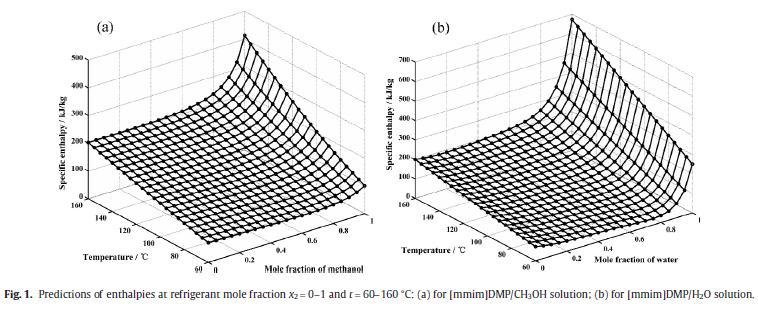The thermodynamic performances of absorption heat transformers (AHTs) using [mmim]DMP/H2O and [mmim]DMP/CH3OH as working fluids were numerically analyzed. Variations in coefficients of performance(COPs), exergy efficiencies, and circulation ratios of the [mmim]DMP/H2O and [mmim]DMP/CH3OH AHTs with varying operating temperatures were simulated and compared with those of the LiBr/H2O system. COPs and exergy efficiencies of the [mmim]DMP/H2O and [mmim]DMP/CH3OH AHTs wereslightly lower than those of the LiBr/H2O system. But the properties of GTL for [mmim]DMP/H2O and [mmim]DMP/CH3OH systems are superior to the LiBr/H2O system. The exergy losses of each component and the entire system for the three working fluids were calculated and compared. Changes in exergy losses with varying absorption, generation, and evaporation temperatures were analyzed. For the [mmim]DMP/H2O and LiBr/H2O systems, the largest exergy losses were produced in generator and evaporator. For the [mmim]DMP/CH3OH system, the largest exergy losses were produced in generator and absorber.
Conclusion
In this study, thermodynamic analysis based on energy and exergy conservations for AHTs using [mmim]DMP/H2O and [mmim]DMP/CH3OH as working fluids is conducted. The obtained result is compared with the thermodynamic performance of an AHT using LiBr/H2O as working fluid. With an increase in tA, COPs decline, circulation ratios grow, and ηex initially increases and then declines continuously. With increases in tG and tE, COPs grow, circulation ratios decline, and ηex shows a declining trend after rising. COPs and ηex for both systems are lower than those for the LiBr/H2O system by less than 10%. However, the properties of GTL for [mmim]DMP/H2O and [mmim]DMP/CH3OH systems are superior to the LiBr/H2Osystem.In the same operating conditions, the numerical relationship of El, total for the three systems is [mmim]DMP/H2O >[mmim]DMP/CH3OH >LiBr/H2O. For the [mmim]DMP/H2O and LiBr/H2O systems,the largest exergy losses are produced in the generator and evaporator;for the [mmim]DMP/CH3OH system, the largest exergy lossesare produced in the generator and absorber.
The results have been published on Applied Thermal Engineering 99 (2016) 846–856.
